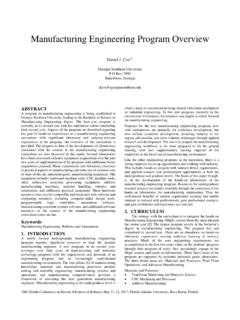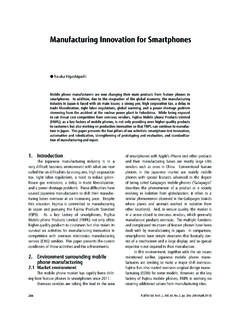Transcription of A Study of Business Models - ccs.mit.edu
1 Do Some Business Models Perform Better than Others? A Study of the 1000 Largest US Firms Authors: Peter Weill, Thomas W. Malone, Victoria T. D Urso, George Herman, Stephanie Woerner Sloan School of Management Massachusetts Institute of Technology MIT Sloan School of Management Working Paper No. MIT Center for Coordination Science Working Paper No. 226 Copyright 2005 Peter Weill, Thomas W. Malone, Victoria T. D Urso, George Herman, and Stephanie Woerner Abstract Despite its common use by academics and managers, the concept of Business model remains seldom studied. This paper begins by defining a Business model as what a Business does and how a Business makes money doing those things. Then the paper defines four basic types of Business Models (Creators, Distributors, Landlords and Brokers). Next, by considering the type of asset involved (Financial, Physical, Intangible, or Human), 16 specialized variations of the four basic Business Models are defined.
2 Using this framework, we classify the revenue streams of the top 1000 firms in the US economy in fiscal year 2000 and analyze their financial performance. The results show that Business Models are a better predictor of financial performance than industry classifications and that some Business Models do, indeed, perform better than others. Specifically, selling the right to use assets is more profitable and more highly valued by the market than selling ownership of assets. Unlike well-known concepts such as industry classification, therefore, this paper attempts to describe the deeper structure of what firms do and thereby generate novel insights for researchers, managers and investors. 1 Draft: May 6, 2004 Draft: May 6, 2004 Do Some Business Models Perform Better than Others? A Study of the 1000 Largest US Firms Few concepts in Business today are as widely discussed and as seldom systematically studied as the concept of Business Models .
3 Many people attribute the success of companies like eBay, Dell, and Amazon, for example, to the ways they used new technologies not just to make their operations more efficient but to create new Business Models altogether. In spite of all the talk about Business Models , however, there have been very few large-scale systematic empirical studies of them. We do not even know, for instance, how common the different kinds of Business Models are in the economy and whether some Business Models have better financial performance than others. This paper provides a first attempt to answer these basic questions about Business Models . To answer the questions, we first develop a comprehensive typology of four basic types of Business Models and 16 specialized variations of these basic types. We hypothesize that this typology can be used to classify any for-profit enterprise that exists in today s economy.
4 As partial confirmation of this hypothesis, we classify the Business Models of the 1000 largest US enterprises. Finally, we analyze various kinds of financial performance data for the different kinds of Business Models to determine whether some Models perform better than others. We find that some Business Models are much more common than others, and that some do, indeed, perform better than others. For example, the most common Business Models for large US companies involve selling ownership of assets to customers ( manufacturers and distributors). However, in the time period of our Study (fiscal year 2000), these Business Models 2 Draft: May 6, 2004 perform less well (in terms of both profitability and market value) than Business Models in which customers use but don t buy assets ( landlords, lenders, publishers, and contractors).
5 This Study does not answer other questions like why these differences exist, whether they are changing over time, or how individual companies can exploit or modify their Business Models to improve their performance. But we hope that the work described here will provide a foundation for future work on these questions. Background Even though the concept of Business model is potentially relevant to all companies, our search of the organization, economic, and strategy literatures, found few articles on Business Models , and no large-scale studies on the topic. Instead several authors have provided useful frameworks for analyzing businesses, such as profit Models (Slywotzky and Morrison, 1997) and strategy maps (Kaplan and Norton, 2004). These approaches are based on a long tradition of classifying firms into internally consistent sets of firms referred to as strategic groups or configurations (Ketchen, Thomas, and Snow 1993).
6 These groups typically conceived of, and organized through the use of typologies and taxonomies ( , Miles and Snow, 1978; Galbraith and Schendel, 1983; Miller and Friesen, 1978) are then often used to explore the determinants of performance. Most of the academic research on Business Models was done in the context of e- Business new ways of doing Business enabled by information technology. Research on e- Business Models has focused primarily on two complementary streams: taxonomies of Business Models and definitions of components of Business Models (Hedman and Kalling, 2001). For example, Timmers (1998) defines a Business model as including an architecture for the product, service, and information flows, a description of the benefits for the Business actors involved, and 3 Draft: May 6, 2004 a description of the sources of revenue.
7 While Timmer s definition does not limit the notion of a Business model to e-commerce, he applies Business Models to that domain, using two dimensions 1) functional integration (number of functions integrated) and 2) degree of innovation (ranging from simply translating a traditional Business to the Internet, to creating completely new ways of doing Business ) resulting in eleven distinct Internet Business Models . Business model definitions and descriptions have proliferated since Timmers. For example, Tapscott, Ticoll, and Lowy (2000) focus on the system of suppliers, distributors, commerce service providers, infrastructure providers, and customers, labeling this system the Business -web or b-web. They differentiate Business webs along two dimensions: control (from self-control to hierarchical) and value integration (from high to low).
8 Weill and Vitale (2001) include roles and relationships among a firm s customers, allies, and suppliers, major flows of product, information, and money, and major benefits to participants in their definition of a Business model. They describe eight atomic e- Business Models , each of which can be implemented as a pure e- Business model or combined to create a hybrid model. Rappa (2003) defines a Business model as the method of doing Business by which a company can sustain itself and notes that the Business model is clear about how a company generates revenues and where it is positioned in the value chain. Rappa presents a taxonomy of Business Models observed on the web, currently listing nine categories. Other definitions of Business Models emphasize the design of the transactions of a firm in creating value (Amit and Zott, 2001), the blend of the value stream for buyers and partners, the revenue stream, and the logical stream (the design of the supply chain) (Mahadevan, 2000), and the firm s core logic for creating value (Linder and Cantrell, 2000).
9 In an attempt to integrate these definitions, Osterwalder, Lagha, and Pigneur (2002) propose an e- Business framework with 4 Draft: May 6, 2004 four pillars : the products and services a firm offers, the infrastructure and network of partners, the customer relationship capital, and the financial aspects. Common to all of these definitions of Business and e- Business Models is an emphasis on how a firm makes money; some go beyond this and discuss creating value. Porter (2001) described the emphasis in Business Models on generating revenues as a far cry from creating economic value . In contrast, Magretta (2002) argued that the strength of a Business model is that it tells a story about the Business , focusing attention on how pieces of the Business fit together - with the strategy describing how the firm differentiates itself and deals with competition.
10 Business Models have the added attraction of being potentially comparable across industries. Defining Business Models For a systematic Study of Business Models , we need to define Business Models and distinguish their different types. We define a Business model as consisting of two elements: (a) what the Business does, and (b) how the Business makes money doing these things. To distinguish different types of Business Models we created a typology of how companies differ in terms of these two elements. Of course, there is no single right way to distinguish different types of Business Models . But some typologies are certainly better or more useful than others. In developing our typology, we focused particularly on trying to achieve the following desirable characteristics (see Scott, 1981, for a related set of criteria for organizational typologies): (1) The typology should be intuitively sensible.









